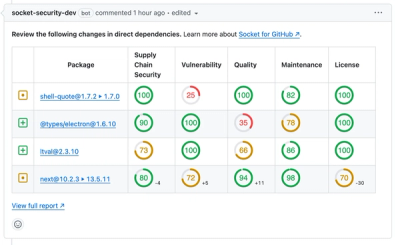
Security Fundamentals
Turtles, Clams, and Cyber Threat Actors: Shell Usage
The Socket Threat Research Team uncovers how threat actors weaponize shell techniques across npm, PyPI, and Go ecosystems to maintain persistence and exfiltrate data.
react-is
Advanced tools
The react-is package is a collection of utilities that allow you to determine the type of a React element. It is useful for type-checking elements and for working with React's different types of components and elements in a more abstract way.
Type-checking elements
This feature allows you to check if a value is a valid React component type or a React element. It's useful for validating props or for conditional rendering logic.
import { isValidElementType, isElement } from 'react-is';
const MyComponent = () => <div>Hello World</div>;
const myElement = <MyComponent />;
const validType = isValidElementType(MyComponent); // true
const elementCheck = isElement(myElement); // trueIdentifying different element types
This feature allows you to identify specific element types like fragments, strict mode wrappers, and portals. This can be useful when writing custom rendering logic or testing components.
import { isFragment, isStrictMode, isPortal } from 'react-is';
const myFragment = <React.Fragment></React.Fragment>;
const myStrictMode = <React.StrictMode></React.StrictMode>;
const myPortal = ReactDOM.createPortal(<div />, document.body);
const fragmentCheck = isFragment(myFragment); // true
const strictModeCheck = isStrictMode(myStrictMode); // true
const portalCheck = isPortal(myPortal); // trueWorking with Context
This feature allows you to check if an element is a Context Provider or a Context Consumer. This is particularly useful in higher-order components or in libraries that need to handle context-related elements.
import { isContextConsumer, isContextProvider } from 'react-is';
const MyContext = React.createContext();
const contextProviderCheck = isContextProvider(<MyContext.Provider value={null}></MyContext.Provider>); // true
const contextConsumerCheck = isContextConsumer(<MyContext.Consumer>{() => null}</MyContext.Consumer>); // trueThe prop-types package is used for type-checking props passed to React components. It provides runtime type checking for React props and similar functionality for validating component inputs, but it does not offer the same utilities for identifying React element types as react-is.
Enzyme is a testing utility for React that makes it easier to assert, manipulate, and traverse your React Components' output. While it includes methods for type-checking and identifying components, it is more focused on testing utilities rather than providing a comprehensive set of type identifiers like react-is.
react-isThis package allows you to test arbitrary values and see if they're a particular React element type.
# Yarn
yarn add react-is
# NPM
npm install react-is
import React from "react";
import * as ReactIs from "react-is";
class ClassComponent extends React.Component {
render() {
return React.createElement("div");
}
}
const FunctionComponent = () => React.createElement("div");
const ForwardRefComponent = React.forwardRef((props, ref) =>
React.createElement(Component, { forwardedRef: ref, ...props })
);
const Context = React.createContext(false);
ReactIs.isValidElementType("div"); // true
ReactIs.isValidElementType(ClassComponent); // true
ReactIs.isValidElementType(FunctionComponent); // true
ReactIs.isValidElementType(ForwardRefComponent); // true
ReactIs.isValidElementType(Context.Provider); // true
ReactIs.isValidElementType(Context.Consumer); // true
import React from "react";
import * as ReactIs from 'react-is';
const ThemeContext = React.createContext("blue");
ReactIs.isContextConsumer(<ThemeContext.Consumer />); // true
ReactIs.isContextProvider(<ThemeContext.Provider />); // true
ReactIs.typeOf(<ThemeContext.Provider />) === ReactIs.ContextProvider; // true
ReactIs.typeOf(<ThemeContext.Consumer />) === ReactIs.ContextConsumer; // true
import React from "react";
import * as ReactIs from 'react-is';
ReactIs.isElement(<div />); // true
ReactIs.typeOf(<div />) === ReactIs.Element; // true
import React from "react";
import * as ReactIs from 'react-is';
ReactIs.isFragment(<></>); // true
ReactIs.typeOf(<></>) === ReactIs.Fragment; // true
import React from "react";
import ReactDOM from "react-dom";
import * as ReactIs from 'react-is';
const div = document.createElement("div");
const portal = ReactDOM.createPortal(<div />, div);
ReactIs.isPortal(portal); // true
ReactIs.typeOf(portal) === ReactIs.Portal; // true
import React from "react";
import * as ReactIs from 'react-is';
ReactIs.isStrictMode(<React.StrictMode />); // true
ReactIs.typeOf(<React.StrictMode />) === ReactIs.StrictMode; // true
19.1.0 (March 28, 2025)
useId to use valid CSS selectors, changing format from :r123: to «r123». #32001href attribute is an empty string #31783getHoistableRoot() didn’t work properly when the container was a Document #32321<!-- -->) as a DOM container. #32250<script> and <template> tags to be nested within <select> tags. #31837exports field to package.json for use-sync-external-store to support various entrypoints. #25231unstable_prerender, a new experimental API for prerendering React Server Components on the server #31724registerServerReference in client builds to handle server references in different environments. #32534FAQs
Brand checking of React Elements.
The npm package react-is receives a total of 85,816,202 weekly downloads. As such, react-is popularity was classified as popular.
We found that react-is demonstrated a healthy version release cadence and project activity because the last version was released less than a year ago. It has 2 open source maintainers collaborating on the project.
Did you know?

Socket for GitHub automatically highlights issues in each pull request and monitors the health of all your open source dependencies. Discover the contents of your packages and block harmful activity before you install or update your dependencies.

Security Fundamentals
The Socket Threat Research Team uncovers how threat actors weaponize shell techniques across npm, PyPI, and Go ecosystems to maintain persistence and exfiltrate data.

Security News
At VulnCon 2025, NIST scrapped its NVD consortium plans, admitted it can't keep up with CVEs, and outlined automation efforts amid a mounting backlog.

Product
We redesigned our GitHub PR comments to deliver clear, actionable security insights without adding noise to your workflow.